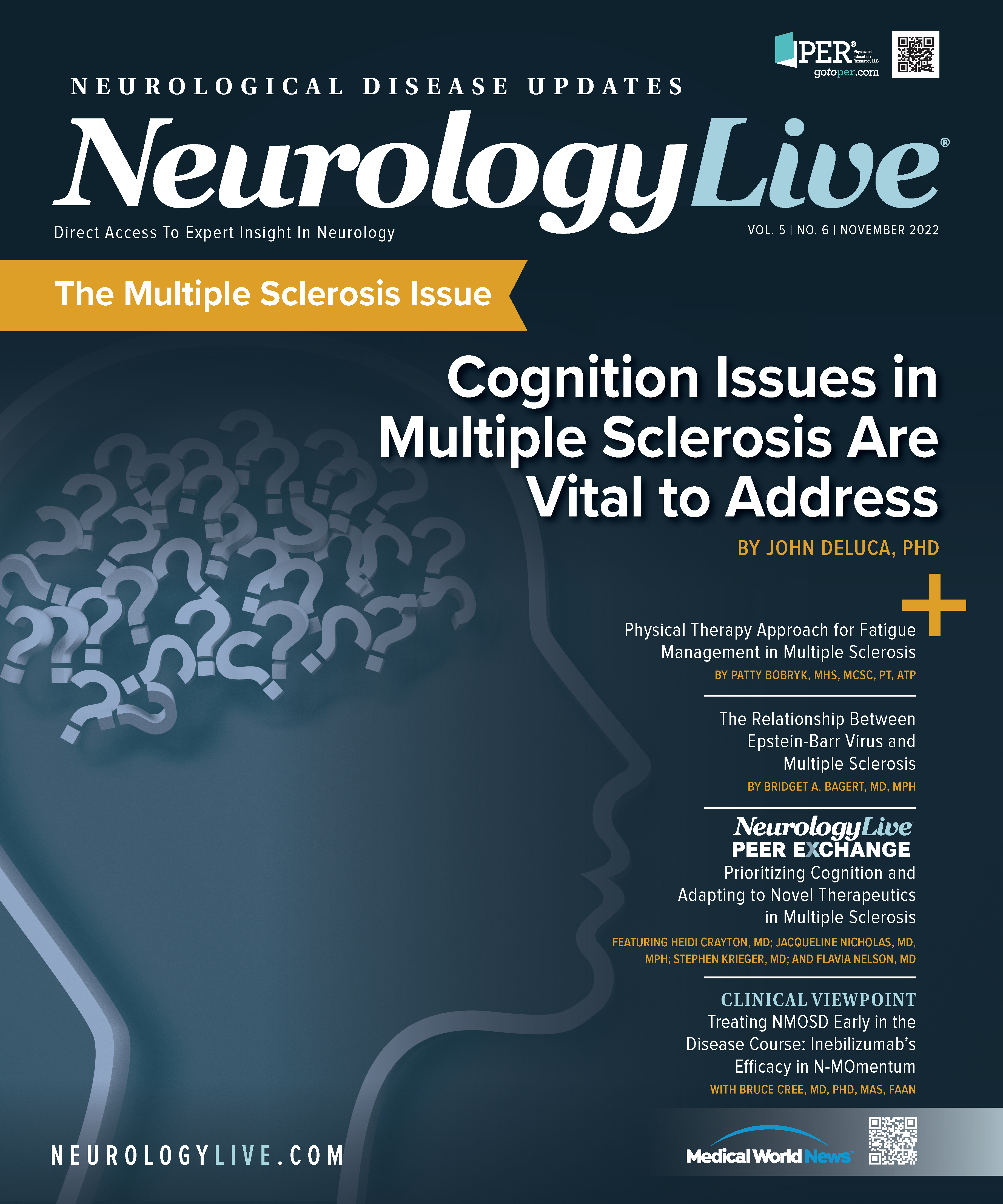Publication
Article
NeurologyLive
Revealing the Unseen in Multiple Sclerosis
Author(s):
Cognitive and other symptoms in multiple sclerosis can be invisible—meaning not readily observed in the individual. However, their impact on a patient’s life can be obvious.
Ahmed Obeidat, MD, PhD

PERSONS WITH MULTIPLE SCLEROSIS (PWMS) are some of my best teachers. Recently, a young woman whom I had followed in my clinic for years developed MS. Yes, I followed her before she developed MS in the way we know it today. She made numerous visits to clinicians, including myself, after experiencing fatigue, cognitive difficulties, migraines, other pains, and episodic paresthesia, and yet no classic lesions appeared on an MRI of her brain, except for a solitary subcortical, humble-looking white spot. Applying the most recent McDonald criteria did not allow for a diagnosis of MS.1 The same was true for results from a 3-Tesla MRI machine that detected only a small lesion anatomically housed in a nonclassic location for demyelination. Years later, a follow-up MRI revealed numerous classic lesions for demyelination and, coupled with some relapsing symptoms, allowed for a diagnosis of clinically definite MS. So when did MS start in this patient?
Growing evidence suggests there is a prodromal phase to MS.2,3 Some study results showed an increased health care utilization years before the diagnosis of MS in various specialties.4-6 Increased visits for headaches, other pains, fatigue, dermatological complaints, and sleep disturbances, among others, were reported. This month’s NeurologyLive® cover story by John DeLuca, PhD, discusses the urgent need to address cognition in MS. Cognitive symptoms can be invisible—meaning not readily observed in the individual. However, their impact on a patient’s life can be obvious.
Cognitive impairment can be retrospectively confirmed to have occurred years before the MS diagnosis.7 A study of military personnel with MS revealed that cognitive impairment was evident years before the official diagnosis through routine serial testing.8 This finding is eye-opening, and the fact that many individuals with a diagnosis of radiologically isolated syndrome show cognitive impairments before any other symptom of MS adds to the importance of cognition in the MS spectrum. It also suggests that invisible neurologic dysfunction likely precedes other overt manifestations such as physical difficulties (eg, weakness, and balance difficulties).9,10 At later stages of MS, cognitive impairment may become visible and debilitating to the person, requiring full-time assistance. Could cognitive testing become a key biomarker to track MS?
Another invisible symptom is fatigue, considered the most commonly reported symptom in MS and affecting more than 80% of PwMS.11 In some, fatigue starts as early as the prodromal stage of the MS spectrum, whereas other patients report fatigue started at later stages. Nevertheless, navigating fatigue in MS is challenging. In this NeurologyLive® issue, Patty Bobryk, MHS, MSCS, PT, ATP, looks at the impact of fatigue on the lives of PwMS and comprehensive, team-based strategies for the management of fatigue. The article provides great insights into a very common, yet very challenging to manage, invisible symptom of MS—fatigue.
The connection between Epstein-Barr virus (EBV) and MS is evolving, yet there are still many unanswered questions of when, what, and how?12,13 The history of EBV infection is nearly universal in PwMS. However, the exact role of the virus in the pathogenesis and pathoprogression of MS is still not completely understood.14 In this issue of NeurologyLive®, Bridget A. Bagert, MD, MPH, discusses our current understanding of the association between EBV and MS and highlights the need for further research to reveal the concealed knowledge surrounding the link.
As I think about the PwMS who taught me about the prodromal phase, I ask myself, “What could I have done differently?” Some investigators were able to detect increased levels of serum biomarkers, such as neurofilament light, in previously stored samples, taken before a patient received a clinical diagnosis of MS.8,15 This is intriguing and suggests invisible axonal degeneration before the clinical onset of MS, perhaps also explaining neurologic symptoms preceding visible changes on conventional MRIs. Advanced imaging techniques in MS may be applied to detect changes in the so-called normal-looking white or gray matter in individuals with risk factors for MS who present with various neurologic symptoms, including cognitive complaints, fatigue, and other relevant prodromal symptoms.16 However, these are costly and currently unavailable in routine clinical practice. Thus, careful investigation and selection of a group of biomarkers that are cost-effective and feasible to be utilized in routine clinical practice could lead to developing a composite biomarker to screen for invisible neuroaxonal damage in individuals with known risk factors for developing MS.
Revealing the unseen in the MS spectrum may start as early as the prodromal stage. With the multitude of effective disease-modifying therapeutics, screening for early signs of MS in genetically and environmentally susceptible individuals may allow careful selection of a group to follow closely in order to diagnose MS as early as the evolving diagnostic criteria allow and thus start disease modification as early as possible.
REFERENCES
1. Thompson AJ, Banwell BL, Barkhof F, et al. Diagnosis of multiple sclerosis: 2017 revisions of the McDonald criteria. Lancet Neurol. 2018;17(2):162-173. doi:10.1016/S1474-4422(17)30470-2
2. Makhani N, Tremlett H. The multiple sclerosis prodrome. Nat Rev Neurol. 2021;17(8):515-521. doi:10.1038/s41582-021-00519-3
3. Tremlett H, Munger KL, Makhani N. The multiple sclerosis prodrome: evidence to action. Front Neurol. 2022;12:761408. doi:10.3389/fneur.2021.761408
4. Yusuf FL, Wijnands JM, Kingwell E, et al. Fatigue, sleep disorders, anaemia and pain in the multiple sclerosis prodrome. Mult Scler J. 2021;27(2):290-302. doi:10.1177/1352458520908163
5. Wijnands JMA, Zhu F, Kingwell E, et al. Prodrome in relapsing-remitting and primary progressive multiple sclerosis. Eur J Neurol. 2019;26(7):1032-1036. doi:10.1111/ene.13925
6. Wijnands JMA, Zhu F, Kingwell E, et al. Five years before multiple sclerosis onset: phenotyping the prodrome. Mult Scler J. 2018;25(8):1092-1101. doi:10.1177/135245851878366
7. Cortese M, Riise T, Bjørnevik K, et al. Preclinical disease activity in multiple sclerosis: a prospective study of cognitive performance prior to first symptom. Ann Neurol. 2016;80(4):616-624. doi:10.1002/ana.24769
8. Bjornevik K, Munger KL, Cortese M, et al. Serum neurofilament light chain levels in patients with presymptomatic multiple sclerosis. JAMA Neurol. 2020;77(1):58-64. doi:10.1001/jamaneurol.2019.3238
9. Lebrun C, Blanc F, Brassat D, Zephir H, de Seze J; CFSEP. Cognitive function in radiologically isolated syndrome. 2010;16(8):919-925. doi:10.1177/1352458510375707
10. Menascu S, Stern M, Aloni R, Kalron A, Magalshvili D, Achiron A. Assessing cognitive performance in radiologically isolated syndrome. Mult Scler Related Disord. 2019;32:70-73. doi:10.1016/j.msard.2019.04.030
11. Broch L, Simonsen CS, Flemmen HØ, et al. High prevalence of fatigue in contemporary patients with multiple sclerosis. Mult Scler J. 2021;7(1):2055217321999826. doi:10.1177/2055217321999826
12. Marcucci SB, Obeidat AZ. EBNA1, EBNA2, and EBNA3 link Epstein-Barr virus and hypovitaminosis D in multiple sclerosis pathogenesis. J Neuroimmunol. 2020;339:577116. doi:10.1016/j.jneuroim.2019.577116
13. Giovannoni G, Vanderdonckt P, Hartung HP, Lassmann H, Comi G. EBV and multiple sclerosis: setting the research agenda. Mult Scler Relat Disord. 2022;67:104158. doi:10.1016/j.msard.2022.104158
14. Soldan SS, Lieberman PM. Epstein-Barr virus and multiple sclerosis. Nat Rev Microbiol. 2022:1-14. doi:10.1038/s41579-022-00770-5
15. Bjornevik K, Cortese M, Healy BC, et al. Longitudinal analysis reveals high prevalence of Epstein-Barr virus associated with multiple sclerosis. Science. 2022;375(6578):296-301. doi:10.1126/science.abj8222
16. Hemond CC, Bakshi R. Magnetic resonance imaging in multiple sclerosis. Cold Spring Harb Perspect Med. 2018;8(5):a028969. doi:10.1101/cshperspect.a028969





